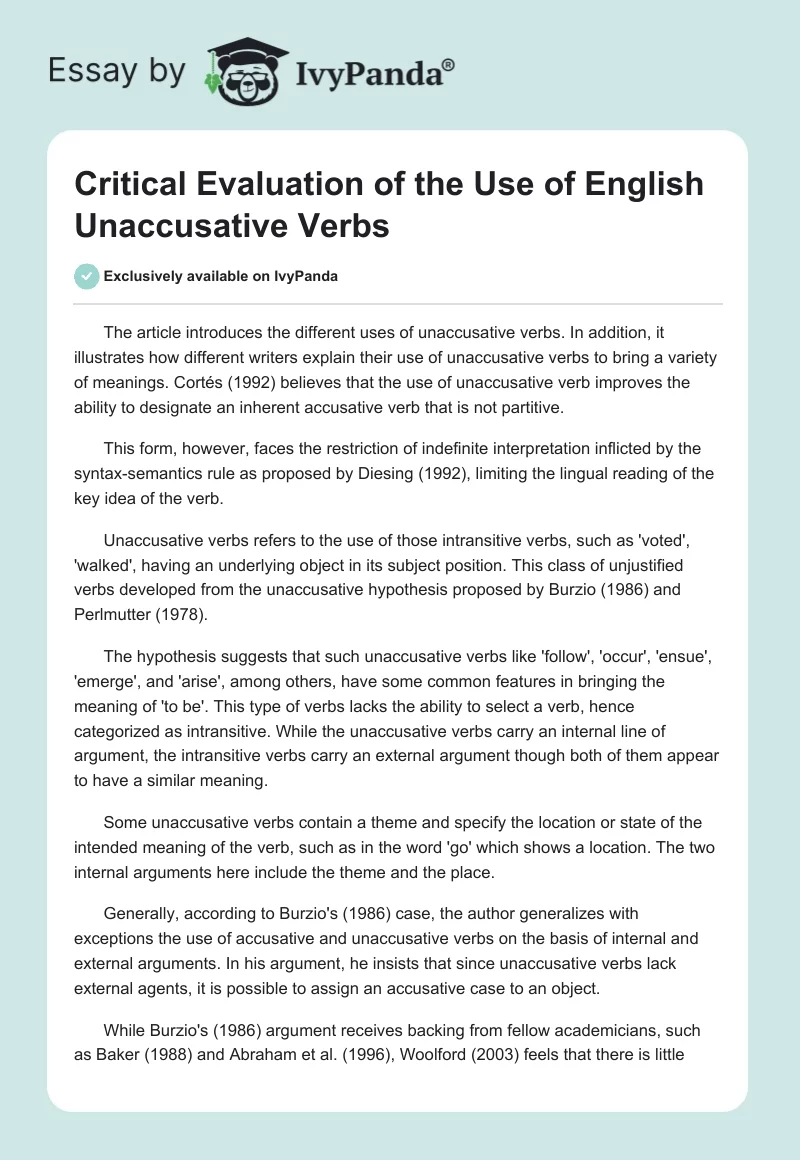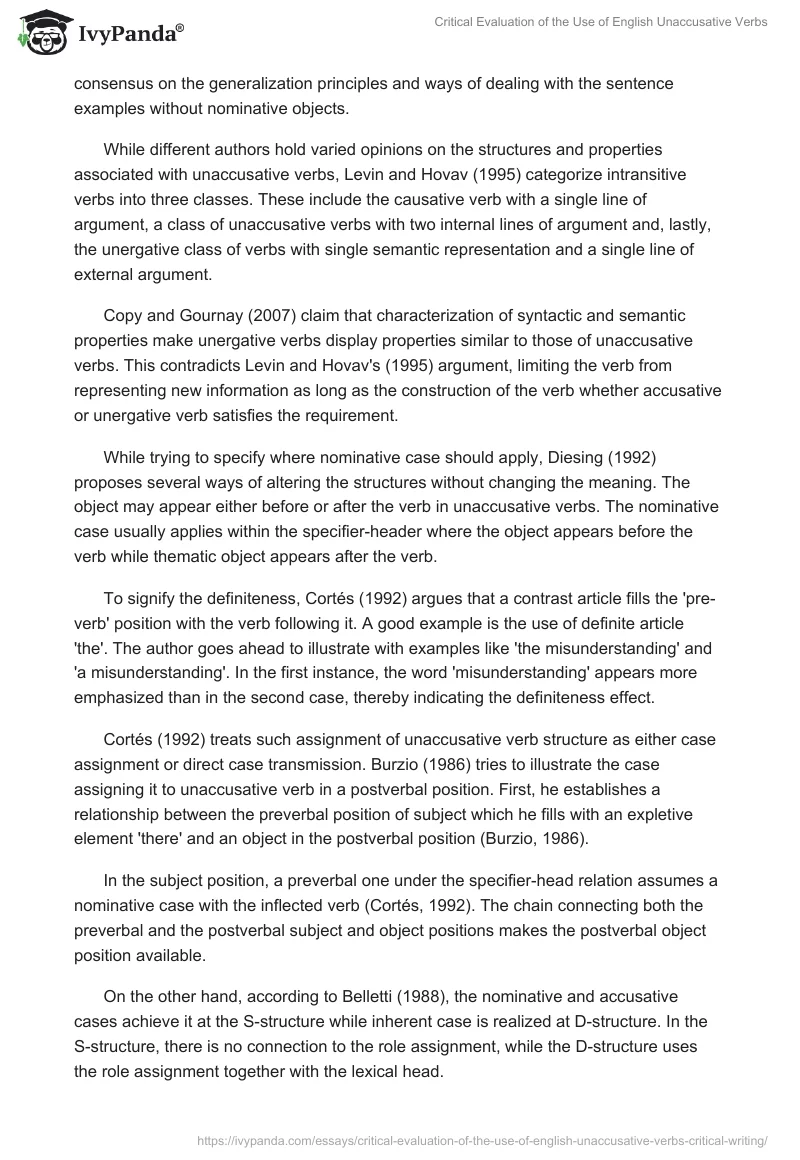The article introduces the different uses of unaccusative verbs. In addition, it illustrates how different writers explain their use of unaccusative verbs to bring a variety of meanings. Cortés (1992) believes that the use of unaccusative verb improves the ability to designate an inherent accusative verb that is not partitive.
This form, however, faces the restriction of indefinite interpretation inflicted by the syntax-semantics rule as proposed by Diesing (1992), limiting the lingual reading of the key idea of the verb.
Unaccusative verbs refers to the use of those intransitive verbs, such as ‘voted’, ‘walked’, having an underlying object in its subject position. This class of unjustified verbs developed from the unaccusative hypothesis proposed by Burzio (1986) and Perlmutter (1978).
The hypothesis suggests that such unaccusative verbs like ‘follow’, ‘occur’, ‘ensue’, ’emerge’, and ‘arise’, among others, have some common features in bringing the meaning of ‘to be’. This type of verbs lacks the ability to select a verb, hence categorized as intransitive. While the unaccusative verbs carry an internal line of argument, the intransitive verbs carry an external argument though both of them appear to have a similar meaning.
Some unaccusative verbs contain a theme and specify the location or state of the intended meaning of the verb, such as in the word ‘go’ which shows a location. The two internal arguments here include the theme and the place.
Generally, according to Burzio’s (1986) case, the author generalizes with exceptions the use of accusative and unaccusative verbs on the basis of internal and external arguments. In his argument, he insists that since unaccusative verbs lack external agents, it is possible to assign an accusative case to an object.
While Burzio’s (1986) argument receives backing from fellow academicians, such as Baker (1988) and Abraham et al. (1996), Woolford (2003) feels that there is little consensus on the generalization principles and ways of dealing with the sentence examples without nominative objects.
While different authors hold varied opinions on the structures and properties associated with unaccusative verbs, Levin and Hovav (1995) categorize intransitive verbs into three classes. These include the causative verb with a single line of argument, a class of unaccusative verbs with two internal lines of argument and, lastly, the unergative class of verbs with single semantic representation and a single line of external argument.
Copy and Gournay (2007) claim that characterization of syntactic and semantic properties make unergative verbs display properties similar to those of unaccusative verbs. This contradicts Levin and Hovav’s (1995) argument, limiting the verb from representing new information as long as the construction of the verb whether accusative or unergative verb satisfies the requirement.
While trying to specify where nominative case should apply, Diesing (1992) proposes several ways of altering the structures without changing the meaning. The object may appear either before or after the verb in unaccusative verbs. The nominative case usually applies within the specifier-header where the object appears before the verb while thematic object appears after the verb.
To signify the definiteness, Cortés (1992) argues that a contrast article fills the ‘pre-verb’ position with the verb following it. A good example is the use of definite article ‘the’. The author goes ahead to illustrate with examples like ‘the misunderstanding’ and ‘a misunderstanding’. In the first instance, the word ‘misunderstanding’ appears more emphasized than in the second case, thereby indicating the definiteness effect.
Cortés (1992) treats such assignment of unaccusative verb structure as either case assignment or direct case transmission. Burzio (1986) tries to illustrate the case assigning it to unaccusative verb in a postverbal position. First, he establishes a relationship between the preverbal position of subject which he fills with an expletive element ‘there’ and an object in the postverbal position (Burzio, 1986).
In the subject position, a preverbal one under the specifier-head relation assumes a nominative case with the inflected verb (Cortés, 1992). The chain connecting both the preverbal and the postverbal subject and object positions makes the postverbal object position available.
On the other hand, according to Belletti (1988), the nominative and accusative cases achieve it at the S-structure while inherent case is realized at D-structure. In the S-structure, there is no connection to the role assignment, while the D-structure uses the role assignment together with the lexical head.
According to Chomsky’s binate theory of syntactic (1986), Belletti (1988) shows the possibility of assigning inherent partitive case to objects of both transitive and unaccusative verbs.
To support his case, Belletti (1988) used data from a Finnish language that has a rich grammar, and which case system contains markings on other areas such as in the accusative. Marking the object of the verb depends on the reading, and accusative or partitive case can form the basis for case marking.
Such examples include marking the whole object or marking in part, the object in question. In other words, the partitive case can be used to mark the unaccusative verb of the Finnish language.
From these data, Belleti conclusively asserts the possibility of using unaccusative verbs to assign partitive case of morphological nature just like the transitive verbs.
The distinction between the two, however, is in the inability of the unaccusative verbs to assign structural accusative case where the transitive verb would comfortably assign the structural case. This goes against case transmission of case assignment although the possibility to capture the definiteness effect can still work.
As a matter of fact, for unaccusative verbs which thematic object appears post-verbally, the structure must assume a set of constraints. Cortés (1992) found out that an expletive ‘there’ must appear pre-verbally in the position of the subject whereas post-verbally, the object must remain indefinite. In such a case, semantic interpretation and not syntactic case factors influence such indefiniteness.
Diesing (1992) studied the domain of extential closure using Kamp-Heim’s approach and concluded that observations of quantification variability of indefinites motivated this approach. Heim (1982) and Kamp (1981) pointed out the semantics of non-deterministic polynomial time as a point of departure from the existential closure.
Diesing further suggested that indefinites differed in their force of quantification contextually. They indefinites further vary based on whether plural or singular form is used, which can take the quantification force from other components within the sentence structure, such as the adverbs like ‘seldom’ or ‘usually’.
According to Russel (2011) and Diesing (1992), indefinites do not have their own force of quantification, thereby borrowing from other components of the sentences in which they appear.
The placement of an adverb observes the strictness of the adjacency rule where the verb first appears followed by the object. The same rule of complacency applies when unaccusative verbs and their thematic postverbal object.
An adverb cannot appear in as the object follows the verb within the same syntactic level. Solving the problem of dealing with the verb ‘be’, Cortés (1992) maintains the indefiniteness rule of the postverbal NP but does not consider the adjacency rule between the verb and the postverbal NP.
Chomsky (1993) agrees with Cortés’ assertions (1992) as he explains how twisting English can happen for the verb to appear at the overt level of the syntax.
On closing discussion on this matter, Diesing’s (1992) proposal is that the NP must appear indefinite to coincide with the existential reading. In other words, the outcome of semantic interpretation can be achieved through realization of the difference between the partitive and accusative cases.
Belleti (1988) and Burzio (1986) carry the internal argument of partitive or quantitative NP. They come to the conclusion that the differences between partitive and quantitative are not structural but simply interpretative. Analysis on the unaccusative verbs’ agreement as observed by the three authors is not consistent in different languages, especially when trying to explain romance.
For instance, in the Catalan language, an intransitive verbs of external argument may be represented as postverbal bare plural subject due to the unaccusative verb’s ability to licence a postverbal bare plural subject.
In conclusion, Eguzkitza and Kaiser (1999) show that in German as well as in other romance languages, the postverbal position of the subject results from the movement arising from the assigning of nominative case. They also propose that the power of the unaccusative hypothesis deals with the problems of postverbal subject constructions with unaccusative verbs.
References
Abraham, W. et al. (1996). Minimal Ideas: Syntactic Studies in the Minimalist Framework. Philadelphia, PA: John Benjamins Publishing Company.
Baker, C. (1988). Key Issues in Bilingualism and Bilingual Education. Avon, England: Multilingual Matters.
Belletti, A. (1988). The Case of Unaccusatives. Linguistic Inquiry, 19, 1-34.
Burzio, L. (1986). Italian Syntax: A Government-Binding Approach. The Netherlands: Springer Science & Business.
Chomsky, N. (1986). Knowledge of Language: Its Nature, Origin, and Use. New York: Praeger.
Cortés, C. (1992). Issues in Catalan Syntax. PhD Dissertation, University of California, Los Angeles.
Diesing, M. (1992). Indefinites. USA: Mit Press.
Eguzkitza, A. & Kaiser, G. A. (1999). Postverbal subjects in Romance and German: Some notes on the Unaccusative Hypothesis. Lingua, 109, 195-219.
Heim, I. (1982). The semantics of definite and indefinite noun phrases. Massachusetts: University of Massachusetts Press.
Kamp, H. (1981). A theory of truth and semantic representation. In J. Groenendijk, T. Janssen & M. Stokhof (Eds.), Formal methods in the study of language: Part I (pp. 513-541). Amsterdam: Mathematisch Centrum Libraries.
Levin, B. & Hovav, M.R. (1995). Unaccusativity: At the Syntax-Lexical Semantics Interface. Massachusetts: MIT Press.
Perlmutter, D. (1978). Impersonal passives and the unaccusative hypothesis. Proceedings of the Fourth Annual Meeting of the Berkley Linguistics Society, 157-189.
Russell, B. (2011). Introduction to Mathematical Philosophy. Toronto: University of Toronto.
Woolford, E. (2003). Burzio’s Generalization, markedness, and constraints on nominative objects. In E. Brandner and H. Zinsmeister (Eds.), New Perspectives on Case Theory (pp. 301-329). Stanford, CA: CSLI.


